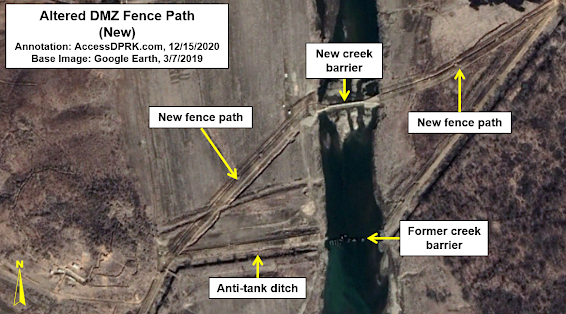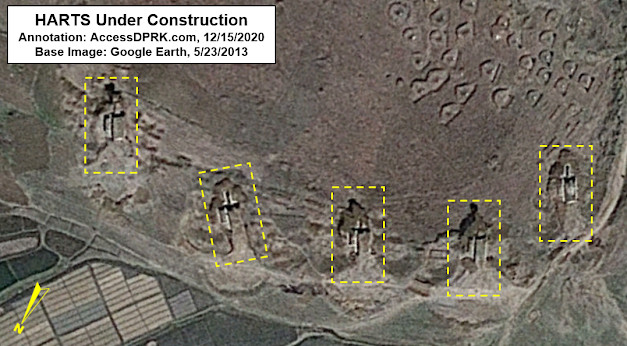This past year has been challenging for just about everyone in one way or another, but thanks to your continued readership and for the support of my Patreon supporters, the AccessDPRK project was able to carry on and have another good year.
Quick Overview
For 2020, I was able to write 24 articles for the project and discuss over 200 analyzed images on Twitter. The AccessDPRK site now has 121 published posts representing 759 pages worth of material. While the blog has been around since 2013, nearly 33% of all traffic to it has been from 2020. Traffic growth from 2019 to 2020 was up 81% as well.
Some social media stats include over 420,000 impressions on Twitter and the addition of 331 new followers. That's three times the number of gained followers in 2019. The project's Facebook page is also slowly growing.
This year's most read article was "North Korea's Underground Navy", closely followed by "Wollo-ri: Much Ado About Something". The article on underground naval facilities also caught the attention of media and was discussed in the International Business Times, Radio Free Asia, and others.
I was also able to make my contributing debuts to 38 North, Asia Times, and National Interest this year.
Lastly, for the third year in a row, RAND Corp. used information from this project to help create one of their reports. For 2020, it was North Korean Conventional Artillery: A Means to Retaliate, Coerce, Deter, or Terrorize Populations.
AccessDPRK 2021 Map
The biggest thing to happen since 2017 was that I completed the mapping process for the upcoming 2021 map. The map will be published in two versions, a Free version and a Pro version.
The Free version will have over 60,000 places marked and will be the most comprehensive map of North Korea ever freely released to the general public.
The Pro version (which will need to be purchased) will have over 1,500 additional sites including detailed maps of North Korea's missile bases and prison camps, hundreds of kilometers of former and new railway, suspected military bases, and more. There will also be a lot of added information throughout the file. I want it to serve as a kind of "one-stop shop" for English-language information relating to North Korea.
To accomplish this, there will be scores of links to relevant information from reputable think tanks, news organizations, NGOs, and others. Part of that task will also be the addition of links from AccessDPRK articles in the various placemarks. For example, the marker for KPA Farm No. 1116 will have a link to the AccessDPRK article about the farm, simplifying research. The same will be done for every mapped site that I have written about.
Related information from CSIS, Arms Control Wonk, 38 North, NK News, CNN, etc. will all be included where necessary.
The Pro version will also have construction dates and other details added to well over a thousand other sites. Cell towers, dams, military bases, new housing developments, mines, etc. will have these extra bits of information when and where I can find them.
I am still considering pricing for the Pro version. I want to make it as accessible as possible, so I may offer the full version but also allow people to purchase item categories themselves. There are over 80 specific types of places mapped. If someone is only interested in the country's electrical grid, then it makes sense to let them purchase those individual files instead of having to buy the entire KMZ map.
I have some extra work left to do to split up the two versions, so I am not sure when I will officially publish the maps, but it will be no later than March. I'll make a separate post giving all of the details.
Finally, I want to mention that Open Nuclear Network reached out to me a few months ago and was able to acquire an early copy of the full map. It's because of their interest that I was able to speed the process up considerably in completing the mapping portion of the project.
Looking to 2021
With the map basically finished and soon the be released, it's time to set new goals.
I already have a few smaller mapping projects in mind that will extend to things like geographic features as well as human structures, but I will mostly be focusing on mining the now completed database for new areas of research and new things to write about.
There's also dozens of places of interest that I will continue to review, as well as keeping up with any new developments elsewhere in the country and news stories. There will definitely be continued posts on here as well as articles written for other sites.
Additionally, I plan to start branching out from North Korea and begin work on China and Iran. I won't be making giant maps like the one for North Korea, but they will cover various military infrastructure and important economic developments. While creating the DPRK map was largely a personal project of mine, I would be happy to work with others already working on Chinese and Iranian matters.
I can announce that the biggest single project for the foreseeable future will be: working on a book! I plan to take much of 2021 to research the book and do some initial work on it. That'll mean needing to buy lots of books, access journals, and digging into various archives. I've had the idea for a book for a few years, but I wanted to finish the primary mapping work before beginning the book work.
I am going to keep the topic a little secret for now, but I will say that it is often brought up when writing about North Korea, but rarely do people go into detail about something that touches on so many aspects of the country.
Patreon
I set up a Patreon account in 2020 and have gained some great supporters. Currently, you can help support the project for $3, $5, $10, $15, and $20 monthly, each coming with their own rewards.
I am constantly thinking about new rewards to add, one of them being that I am working on a kind of virtual tour of the country. But you can already get early access to new articles, monthly digests, you can have me analyze places you're interested in, and get access to exclusive datasets. Plus, blog and Twitter mentions for any support at $3 or more.
If you believe in sharing facts-based information with the public about all aspects of North Korea (defense, culture, economy) as well as China and Iran (upcoming), please think about helping out. Every dollar really does help make this possible.
With that, I want to give a huge THANK YOU to my current Patreon supporters: Amanda O., Anders O., GreatPoppo, Joel Parish, John Pike, Kbechs87, Planefag, Russ Johnson, and ZS.
And I want to wish everyone a wonderful upcoming year.














